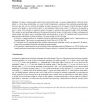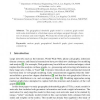CORR
2010
Springer
14 years 3 months ago
2010
Springer
Abstract Consider a random graph model where each possible edge e is present independently with some probability pe. Given these probabilities, we want to build a large/heavy match...
RSA
2006
14 years 5 months ago
2006
Consider the random graph model of Barab
OPODIS
2008
14 years 6 months ago
2008
Kleinberg [17] proposed in 2000 the first random graph model achieving to reproduce small world navigability, i.e. the ability to greedily discover polylogarithmic routes between a...
CAAN
2004
Springer
14 years 10 months ago
2004
Springer
It appeared recently that the classical random graph model used to represent real-world complex networks does not capture their main properties. Since then, various attempts have ...
WAW
2007
Springer
14 years 11 months ago
2007
Springer
The geographical threshold graph model is a random graph model with nodes distributed in a Euclidean space and edges assigned through a function of distance and node weights. We st...
FOCS
2008
IEEE
14 years 11 months ago
2008
IEEE
A plethora of random graph models have been developed in recent years to study a range of problems on networks, driven by the wide availability of data from many social, telecommu...
RECOMB
2004
Springer
15 years 5 months ago
2004
Springer
Nuclear magnetic resonance (NMR) spectroscopy allows scientists to study protein structure, dynamics and interactions in solution. A necessary first step for such applications is ...
ICML
2006
IEEE
15 years 6 months ago
2006
IEEE
In recent years, there has been a proliferation of theoretical graph models, e.g., preferential attachment and small-world models, motivated by real-world graphs such as the Inter...


